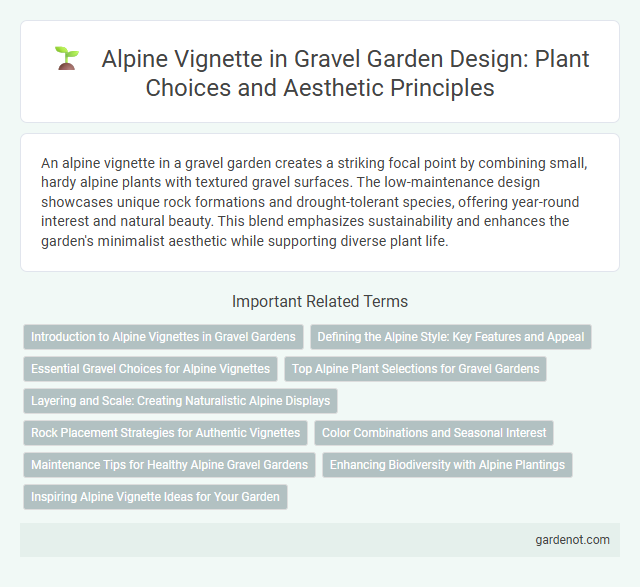An alpine vignette in a gravel garden creates a striking focal point by combining small, hardy alpine plants with textured gravel surfaces. The low-maintenance design showcases unique rock formations and drought-tolerant species, offering year-round interest and natural beauty. This blend emphasizes sustainability and enhances the garden's minimalist aesthetic while supporting diverse plant life.
Introduction to Alpine Vignettes in Gravel Gardens
Alpine vignettes in gravel gardens showcase compact, hardy plants that thrive in well-drained, rocky soils with minimal water. These miniature landscapes feature species such as saxifrage, sedum, and alpine asters, offering year-round texture and color while enhancing biodiversity. Incorporating alpine vignettes helps create visually striking, low-maintenance gravel gardens that mimic natural mountain habitats.
Defining the Alpine Style: Key Features and Appeal
Alpine vignette gardens showcase hardy, low-maintenance plants adapted to rocky, well-drained soils, emphasizing naturalistic arrangements that mimic high-altitude environments. Key features include compact, drought-tolerant alpine flowers such as saxifrages, sedums, and edelweiss, combined with gravel or scree beds to enhance drainage and aesthetic authenticity. The appeal lies in its minimalist beauty and ecological resilience, making it ideal for sustainable gravel gardens that require minimal watering and support biodiversity.
Essential Gravel Choices for Alpine Vignettes
Selecting the right gravel is essential for alpine vignettes to mimic mountainous terrain and ensure proper drainage. Crushed granite, quartzite, and limestone chips provide excellent texture and color contrast against alpine plants like sedums and saxifrages. Opting for angular gravel over rounded pebbles enhances soil aeration and prevents compaction, promoting healthy root growth in these specialized garden settings.
Top Alpine Plant Selections for Gravel Gardens
Top alpine plant selections for gravel gardens include Sedum spurium, Saxifraga arendsii, and Androsace sempervivoides, known for their drought tolerance and compact growth. These species thrive in well-drained, rocky soils typical of gravel gardens, providing vibrant colors and textured foliage through the growing season. Incorporating such resilient alpine plants enhances garden aesthetics while minimizing maintenance in gravel landscape designs.
Layering and Scale: Creating Naturalistic Alpine Displays
Layering and scale are essential in creating naturalistic alpine vignette displays within gravel gardens, ensuring a dynamic yet harmonious composition. Incorporate varying heights and textures by combining low-growing alpines such as Saxifraga with tussock grasses and taller rock plants like Edelweiss to replicate mountain habitats. Strategic placement of diverse plant forms and gradual transitions in size enhances depth and mimics the uneven contours of alpine landscapes.
Rock Placement Strategies for Authentic Vignettes
Strategic rock placement in Alpine vignettes enhances authenticity by mimicking natural mountainous terrain, using varied sizes and textures to create depth and interest. Position larger, weathered stones in focal areas to anchor the composition while scattering smaller rocks organically to simulate erosion and natural layering. Integrating crevices and angular placements supports drought-tolerant alpine plants, promoting both aesthetic appeal and ecological harmony in gravel garden designs.
Color Combinations and Seasonal Interest
Alpine vignette plantings in gravel gardens excel through vibrant color combinations, blending pastel hues of Sedums and Sempervivums with the bold reds and purples of Saxifraga and Aubrieta. Seasonal interest is heightened by early spring blooms of Crocus and alpine primroses, followed by summer flowering of Phlox subulata and autumnal tints in alpine grasses. This dynamic palette ensures a year-round display that thrives in well-drained, stony substrates.
Maintenance Tips for Healthy Alpine Gravel Gardens
Alpine gravel gardens thrive with well-drained, rocky soil that mimics mountainous habitats, requiring minimal watering and occasional weeding to maintain their charm. Use sharp, gritty soil and avoid over-fertilizing to prevent root rot and encourage compact growth of alpine plants like Saxifraga and Sempervivum. Regularly remove debris and monitor for pests, ensuring the garden remains healthy and visually appealing through seasonal care.
Enhancing Biodiversity with Alpine Plantings
Alpine vignette gardens introduce a diverse range of hardy, low-maintenance species that thrive in rocky, well-drained soils, significantly enhancing local biodiversity. These plantings provide essential habitats and food sources for pollinators such as bees and butterflies, boosting ecosystem resilience. Integrating alpine species like saxifrage, edelweiss, and alpine asters creates a dynamic gravel garden environment that supports a variety of microfauna and promotes ecological balance.
Inspiring Alpine Vignette Ideas for Your Garden
Inspiring Alpine vignette ideas transform gravel gardens into stunning displays of hardy, low-maintenance plants like saxifrages, sedums, and dwarf conifers, perfectly suited for rocky, well-drained soils. Incorporating natural stone arrangements and miniature rockeries enhances the authenticity, providing both texture and a sense of rugged elegance. These alpine-inspired features promote biodiversity while creating year-round visual interest through varied foliage colors and delicate mountain blooms.
Alpine vignette Infographic

 gardenot.com
gardenot.com